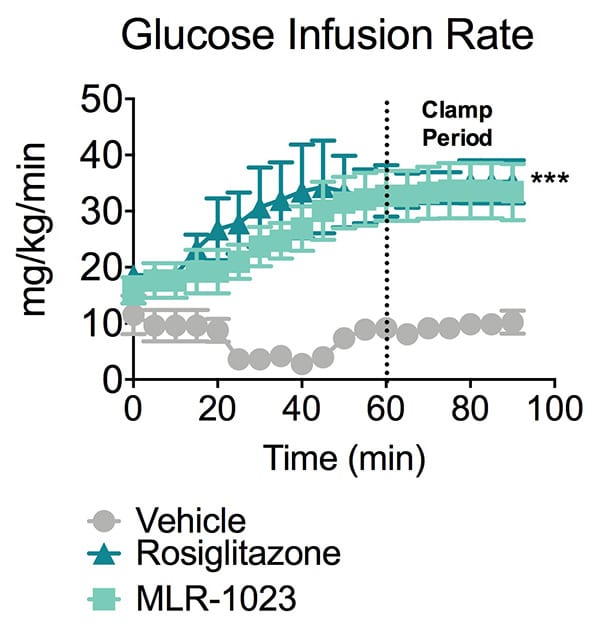Euglycemic / Hyperglycemic Clamp Study
Discover how Melior’s unique phenotypic screening platforms can uncover the untapped value of your candidate therapeutic
The hyperinsulinemic/euglycemic clamp (glucose clamp) is the gold standard method for detecting insulin sensitivity and glucose utilization in experimental animals and in humans.
During the study, insulin is infused intravenously (IV) at a steady rate and blood glucose levels maintained at some predetermined level (e.g. 100 mg/dL for euglycemic state) by variable infusion of glucose. At steady-state, the glucose infusion rate (GIR) is equal to whole-body glucose uptake and utilization.
Drugs, such as the thiazolidinones (PPARγ agonists; e.g. rosiglitazone) and MLR-1023 improve insulin sensitivity and thereby increase GIR in animals subjected to the euglycemic clamp. Other classes of diabetic agents such as sulfonylureas, DPP-4 inhibitors and SGLT2 inhibitors do not exhibit activity in a clamp study. Therefore, a glucose clamp is a useful tool to understand the mechanism of action for some metabolically active therapeutics or insulin sensitizers.
Ready to get started or looking for a custom model?
Contact us today for more information about our bespoke research models and to discuss how we can help you answer your unique research questions.

Insulin was infused at a constant rate of 20 mU / kg/min into Zucker fa/fa insulin resistant rats. Glucose infusion rate was adjusted to maintain a plasma glucose level of 100±10 mg/dL. As illustrated, steady state was achieved after 60 minutes and maintained for an additional 30 minutes.
The data above illustrate that MLR-1023, like rosiglitazone yields a significantly higher rate of glucose infusion to maintain steady glucose levels relative to vehicle treated animals. This is as a result of both of these compound restoring insulin sensitivity.
Data are mean ± SEM; ***p<0.001 compared to vehicle (N=6).
The actual glucose clamp procedure normally takes about 2-3 hours / animal. However, drugs such as thiazolidinediones (TZDs; e.g. rosiglitazone) can require dosing for a week or more to achieve maximal effect. Also, Melior does normally complete the clamp procedure on all study animals over two or more days. Therefore, a typical clamp study typically takes 2 or more weeks to complete. Groups sizes are normally 6 to 10 animals.
Frequently Asked Questions
The plasma insulin concentration is acutely raised and maintained by a continuous infusion of insulin. Meanwhile, the plasma glucose concentration is held constant at basal levels by a variable glucose infusion. When the steady-state is achieved, the glucose infusion rate equals glucose uptake by all the tissues in the body and is therefore a measure of tissue insulin sensitivity. The hyperinsulinemic clamps are often used a gold standard method for evaluating insulin sensitivity.
Animals will not be fasted based on our protocol.
Yes. All our clamp studies are performed in conscious rats.
Blood glucose is measured every 5 minutes during the study.
Synonyms: glucose clamp, euglycemic clamp, hyperinsulinemic clamp
insulin sensitivity



 Interested in running a Glucose Clamp study?
Interested in running a Glucose Clamp study?